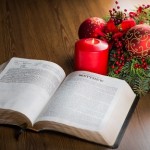 Sing unto the Lord with the harp; with the harp, and the voice of a psalm. – Psalm 98:5
Sing unto the Lord with the harp; with the harp, and the voice of a psalm. – Psalm 98:5
My preceding posts on reading Gregorian chant didn’t go into how to play it on the wire-strung harp.
Gregorian chant is a vocal music, not an instrumental one. So there’s a little bit of re-interpretation here. Wire harps, unlike nylon-strung Celtic harps, ring for quite a while after you pluck a string with your nails, unless you damp them immediately with your finger pads. This trait allows you to simulate some of the aspects of singing.
If you pluck a note on your wire harp and let it ring, consider it as a sung note. When you play the next one, it will blend in with the previously played note (unless damped), creating a vocal line that rises or falls, depending on the written melody.
Repeated notes in chant merit their own discussion.
Depending on the context, you can either choose to play these as one long sustained note and not pluck them rapidly three times…
Or.
You can play them with an alternating improvised counterpoint, as long as the notes you choose are appropriate to that mode (i.e. don’t play a Bb if the mode doesn’t call for one). Using the above example to illustrate this idea, the effect will have a rather Baroque feel, reminiscent of Vivaldi violin concertos: Ex. C, B, C, A, C, G then F, E, F, D, F, C, F.
When I play this latter style on my wire harp I tend to play the repeating note with one hand and the descending (or ascending) notes with the other. It’s especially easy on my little cross-strung wire harp Esabelle, because if I need the Bb it’s right there in the middle of the string course and at the top on the left side of the harp.
On the subject of wire harp damping:
I don’t tend to damp much either with the Baroque style of alternating notes… I just let them ring. Then I might lightly damp the last note and move on to the next set of neums. But I find that excessively heavy damping does not sound very good; it tends to cause an inappropriate abruptness which is not conducive to a meditative quality in church harp music. The only time I do some damping is if there are a fair amount of consecutive seconds which may clash, but even there it’s quite light and subtle. I’ve found a way of playing ornaments and graces quickly with some rapid fingerpad damping which does not draw overt attention to itself. The idea is to make the wire harp sound like it is singing and fading gracefully away in the church’s acoustic resonance space like an echoing cathedral pipe organ, not like it is abruptly starting and stopping. This latter style is more suitable for secular music.
Also I tend to touch the wires lightly on initial contact with my fingernails and not “dig” into them, so there is no harshness of tone, even at louder volumes. The idea is to play the room, much as the pipe organ does, and let that space resonate, even more so than my harp’s soundbox does. To accomplish this, I try to point my soundboard up at the church’s ceiling and back corner so that the sound waves coming off of my harp are reflected back into the sanctuary space. After some experimenting I can usually find the sweet spot and make the entire worship area easily resonate, along with the pipe organ.
My wire harps ideally, should sound sweet and angelic in church… singing as a heavenly chorus of angels. At no time should any of my harps sound strident, brash or hint at the worldly, pop culture of our times. The tonal ideal is to be transcendent, helping the congregation to pray and to seek unity with our Lord and Savior in His House.

